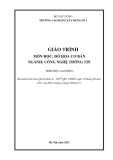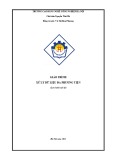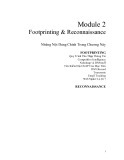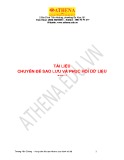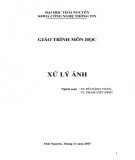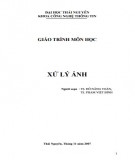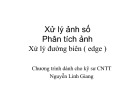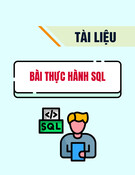145
Special Issue
JOURNAL OF SCIENCE AND TECHNOLOGY DONG NAI TECHNOLOGY UNIVERSITY
ADVANCING INDUSTRIAL VISUALIZATION: DESIGN AND IMPLEMENTATION OF A 3D VISUALIZATION SERVICE ARCHITECTURE FOR 2D CAD DATA
1Dong Nai Technology University 2National Cheng Kung University *Corresponding author: Truong Ho Xuan, hoxuantruong@dntu.edu.vn
Truong Ho Xuan1*, Nguyen Ngoc Tu2
GENERAL INFORMATION
ABSTRACT
Received date: 28/03/2024
Revised date: 16/05/2024
Accepted date: 13/07/2024
KEYWORD
3D;
Architecture;
CAD;
Industrial;
Visualization;
The paper describes a new architecture for 3D visualization service, made to convert 2D CAD data into comprehensive 3D models. It is created with focus on multi-device environments in industrial uses. The architecture brings together three major parts: a parser for 2D CAD, generator of the model in 3 dimensions and system of transmission that is hybrid. The first part, the parser for 2D CAD extracts important shape and size details from files produced by computer-aided design (CAD) software; then this information gets used by the second part - generator to automatically make very detailed three-dimensional models without needing any manual input. The hybrid transmission system makes sure that these models can be seen without any problems on different devices such as a desktop, tablet and also AR device like Hololens 2. Experiments results show how well it works to convert 2D CAD data into 3D models correctly with very precise matching of the original designs. The performance of this system was checked on many platforms, showing strong abilities for real-time transmission and creating images. The 2D Parser, which is done in Javascript and Three.js, worked well inside browser surroundings. The 3D Generator was made using Unity and it performed reliably as a Windows program. The transmission system was constructed with nodeJs, Javascript, Electron and a STUN server. It supported smooth operations under various network conditions and device resolutions. Tests done on Hololens 2 for visualization showed that the download of 3D objects worked successfully and they were depicted accurately which demonstrated how this architecture has potential to improve industrial workflows.
146
Special Issue
JOURNAL OF SCIENCE AND TECHNOLOGY DONG NAI TECHNOLOGY UNIVERSITY
1. INTRODUCTION
The relentless march of
research, meticulous
revolutionize
technologies, these
elucidating its
technological innovation continues to redefine the landscape of industries worldwide, with virtual space service technologies standing at the forefront of this transformative wave (Byun & Sohn, 2020). Concepts such as Extended Reality (XR), digital twins, and the metaverse hold immense promise, offering novel ways to interact with digital environments and traditional workflows (Peng et al., 2024). Among the myriad their applications of integration into manufacturing and industrial education sectors stands out as a beacon of opportunity, poised to fundamentally alter how we conceive, design, and produce physical objects (Aheleroff et al., 2021).
fidelity
methodologies and integrating cutting-edge technologies, our architectural framework aims to serve as a foundational cornerstone for the effective utilization of 2D CAD data in industrial settings (Bouchlaghem et al., 2005; Xu, 2021). Through a holistic exploration of related design considerations, and thorough experimentation, we endeavor to not only fill the existing void but also pave the way for new avenues of exploration and innovation in the visualization and manipulation of complex 3D objects derived from traditional 2D designs. We delve into the intricacies of our proposed service its architecture, constituent implementation components, detailing process, and presenting the results of our experimental endeavors. By elucidating the practical underpinnings, theoretical considerations, and real-world implications of our architectural framework, we aim to provide a comprehensive resource for researchers, practitioners, and industry stakeholders alike, propelling the field of 3D visualization and design automation into uncharted territory (Rohil & Ashok, 2022).
2. RELATED WORK
have explored
Central to this paradigm shift is the seamless translation of 2D Computer-Aided Design (CAD) blueprints into immersive 3D models, enabling stakeholders to visualize, and manipulate designs with analyze, unprecedented interactivity and (Hagedorn & Döllner, 2007; Mouton et al., 2014). While significant strides have been made in automating the conversion process and facilitating real-time transmission of 3D data, a critical gap persists in the realm of service architectures tailored to this specific challenge. Indeed, despite the proliferation of research and development efforts in this domain, there remains a dearth of comprehensive frameworks capable of seamlessly bridging the gap between 2D CAD data and fully realized 3D models, especially within industrial contexts (Hagedorn & Döllner, 2007).
designed and from CAD
to parse 2D CAD
The pursuit of automating the generation of 3D models from 2D CAD data has been a focal point of research across various disciplines. Researchers numerous methodologies and approaches aimed at addressing this challenge. One notable avenue of investigation focuses on the automatic conversion of 2D CAD designs into 3D models. Various methods have been proposed, including those leveraging computer vision algorithms to extract shape, position, and numerical data characters images. These approaches aim to achieve high-fidelity 3D reconstruction with minimal user model spatial intervention, often by analyzing This paper study this gap by presenting a rigorously meticulously implemented service architecture expressly crafted files and autonomously generate corresponding 3D state-of-the-art leveraging models. By
147
Special Issue
JOURNAL OF SCIENCE AND TECHNOLOGY DONG NAI TECHNOLOGY UNIVERSITY
relationships within CAD images or utilizing machine learning algorithms to infer geometric properties from 2D CAD elements. leveraging advancements
encompassing a wide range of methodologies and innovations. By building upon previous in research and computer vision, machine learning, and networking technologies, our proposed service architecture aims to advance the state of the art in automated 3D modeling and visualization for industrial applications.
and technologies 3. DESIGN OF 3D VISUALIZATION SERVICE ARCHITECTURE
a
form
These
various
that bridges
across and
cohesive components the gap architectural framework between 2D CAD data and immersive 3D visualizations. By integrating parsing, generation, and transmission functionalities, the architecture offers a versatile solution for industrial applications, unlocking new avenues for visualization and manipulation of complex 3D objects derived from traditional 2D designs, shown in Figure 1
The proposed 3D visualization
a
constitutes
Efficient transmission of 3D models to diverse devices and platforms is another critical aspect of 3D visualization services. To address this challenge, researchers have proposed hybrid transmission systems that leverage web- peer-to-peer based networking protocols. These systems aim to achieve real-time transmission of high-fidelity hardware 3D models conditions. network configurations Strategies server-side include combining rendering with client-side streaming, offloading rendering tasks to the server, and streaming compressed data to client devices. Additionally, distributed rendering techniques in conjunction with content delivery networks (CDNs) have been explored to achieve scalable and robust 3D model transmission, ensuring optimal performance and reliability in distributing 3D content to geographically dispersed users.
into
and parsing Integrating
studies have
service architecture comprehensive framework for the seamless translation of 2D CAD data immersive 3D models, facilitating visualization across diverse device ecosystems. This architectural design encompasses three core components: the 2D CAD file parser, the 3D model generator, and the hybrid transmission system, each intricately integrated to ensure efficient processing and dissemination of 3D models.
image combining
Figure 1. Architecture for 3D Visualization
generation components seamlessly is crucial for efficient 3D model creation within service architectures. Several investigated novel approaches to streamline the workflow from 2D CAD data to fully realized 3D models. Unified frameworks parsing techniques with geometric modeling algorithms aim to automate 3D model generation from CAD images, achieving high-quality 3D reconstructions with minimal user intervention. integrating parsing, Modular architectures generation, and validation components into cohesive pipelines enable robust and scalable 3D model generation from diverse 2D CAD data sources, leveraging rule-based parsing and statistical validation techniques. The landscape of related work in automatic 3D modeling and visualization services is rich and diverse,
Services
148
Special Issue
JOURNAL OF SCIENCE AND TECHNOLOGY DONG NAI TECHNOLOGY UNIVERSITY
3.1. 2D CAD File Parser enabling seamless visualization hardware diverse latency, experiences across configurations and network conditions.
4. EXPERIMENTAL RESULTS
The
to evaluate
3D model subsequent
the proposed 3D implementation of involved visualization service architecture rigorous experimentation its performance, functionality, and suitability for industrial applications. This section presents the outcomes of these experiments, detailing the tools and technologies utilized, as well as the observed results.
At the heart of the architecture lies the 2D CAD file parser, tasked with the critical function of loading and parsing 2D CAD files. Upon loading, the parser organizes CAD files under a common 'target name,' streamlining subsequent processing and generation tasks. As CAD files are selected for parsing, the parser meticulously extracts essential data such as length, angle, position, and section images. This extracted information serves as the foundation generation, for facilitating the seamless transition from 2D representations to fully realized 3D objects.
3.2. 3D Model Generator
the phase, parsing Following
users with
The architecture's key components were implemented using a variety of technologies tailored to their specific functionalities. The 2D Parser, responsible for loading and parsing CAD files, was developed in Javascript and Three.js, enabling seamless operation within web browsers. Meanwhile, the 3D Generator, tasked with constructing 3D models from parsed CAD data, was implemented using Unity and operates as a Windows program. Additionally, the hybrid transmission system, facilitating real-time transmission of 3D models, was realized using a combination of nodeJs, Javascript, Electron, Three.js, and a STUN server. This multi-faceted approach ensured transmission efficient communication and across diverse device ecosystems. the architecture employs a 3D model generator to autonomously construct 3D models based on the extracted CAD data. Leveraging the parsed information, the generator analyzes section images and numerical data to infer geometric properties and spatial relationships. Through a series of calculations and validations, the generator produces high-fidelity 3D models faithful to the original 2D CAD designs. This automated process ensures consistency and accuracy across diverse CAD datasets, immersive empowering visualizations of complex objects without manual intervention.
3.3. Hybrid Transmission System
rendering
rapid parsing
through web-based
exhibited
heterogeneous combining
facilitated system Completing the architecture is the hybrid transmission system, designed to efficiently disseminate generated 3D models to various devices technologies. Leveraging individualized connections, this system ensures real-time transmission of 3D device across models server-side ecosystems. By rendering with client-side streaming, the system optimizes performance and minimizes Performance evaluation of the architecture encompassed several key metrics, including processing speed, fidelity, and transmission efficiency. The 2D Parser capabilities, demonstrated efficiently extracting essential data from CAD files within web browsers. Similarly, the 3D Generator commendable performance, autonomously constructing high- fidelity 3D models from parsed CAD data as a Windows program. Furthermore, the hybrid seamless transmission transmission of 3D models to diverse devices,
149
Special Issue
JOURNAL OF SCIENCE AND TECHNOLOGY DONG NAI TECHNOLOGY UNIVERSITY
and minimizing optimizing performance latency through individualized connections. enhanced visualization and manipulation capabilities.
demonstrated architecture
Functional validation of the architecture involved assessing its ability to accurately translate 2D CAD data into immersive 3D visualizations. Through a series of validation tests, including comparison against ground truth CAD models and user feedback sessions, robust the functionality and accuracy. Users reported high levels of fidelity and realism in the generated 3D models, highlighting the architecture's suitability for industrial visualization tasks.
Figure 2. The two-dimensional computer-
The showcased architecture
aided design (2d cad) parser: a comprehensive tool for extracting and processing cad data
industrial
in loading CAD
Figure 3. The comprehensive monitoring system for real-time oversight and managemen
transmission
Figure 4. The visualization with hololens 2:
augmented reality integration for immersive experience
its settings. effectiveness within Leveraging industrial CAD datasets and user feedback, the architecture was deployed across diverse operational environments. Feedback from stakeholders indicated a high degree of satisfaction with the architecture's performance, with notable improvements in visualization capabilities and workflow efficiency observed across various use cases. Fig. 2 depicts an example screen of the 2D Parser, showcasing its files and functionality displaying section images. Additionally, Fig. 3 illustrates the monitoring system of the hybrid transmission system, enabling validation of connections and confirming successful 3D model downloads. Finally, Fig. 4 displays the visualization of matched 3D models on the HoloLens 2 screen, corresponding to the target models, affirming successful implementation and visualization on AR devices. The experimental results underscore the efficacy and versatility of the proposed 3D visualization service architecture in industrial applications. By seamlessly integrating parsing, generation, functionalities, and the architecture offers a robust solution for translating 2D CAD data into immersive 3D users with empowering visualizations,
150
Special Issue
JOURNAL OF SCIENCE AND TECHNOLOGY DONG NAI TECHNOLOGY UNIVERSITY
5. DISCUSSION
results unveil The experimental
demands challenges
implications of these the and development
the through the potential and effectiveness of the proposed 3D visualization service architecture in tackling the complexities inherent in transforming 2D CAD data into immersive 3D models tailored for industrial applications. This discussion delves into findings, identifies inherent limitations and challenges, and outlines promising avenues for future exploration and development.
to seamlessly
into
in
constraints and network conditions, particularly in resource-limited environments or areas with restricted internet connectivity. Overcoming these continual optimization efforts and the development of adaptive algorithms capable of accommodating a spectrum of hardware configurations and network conditions. Several avenues for future emerge. research Strengthening the architecture's resilience and adaptability integration of advanced error handling mechanisms and adaptive algorithms could mitigate the impact of variations in CAD data quality and hardware constraints. Furthermore, delving the potential of emerging technologies such as augmented reality (AR) and virtual reality (VR) to enrich the visualization and interaction capabilities of the architecture represents a promising trajectory. By harnessing AR and VR technologies, stakeholders could immerse themselves lifelike 3D environments, facilitating more intuitive collaboration and decision-making processes.
The exploring and
system ensure
The findings underscore the architecture's capacity integrate parsing, generation, and transmission functionalities, thereby facilitating efficient visualization of 3D models across a diverse array of device ecosystems. cutting-edge Leveraging technologies like computer vision, machine learning, and web-based transmission protocols, the architecture emerges as a robust solution poised to address the visualization needs of industrial sectors. The swift parsing capabilities exhibited by the 2D Parser, combined with the high-fidelity 3D model generation prowess of the 3D Generator, contribute to heightened workflow efficiency and productivity within industrial settings. Moreover, the real-time transmission capabilities inherent in the hybrid optimal transmission performance and minimal latency, fostering seamless collaboration and communication among stakeholders.
underscore the poses potential
architecture in
the However, the architecture is not immune to limitations and challenges. Notably, its reliance formatting and on precise CAD data consistency hurdle, a particularly in scenarios where CAD data quality varies. Ensuring compatibility with diverse CAD formats and standards remains an ongoing challenge that necessitates careful architecture's attention. Additionally, performance may be susceptible to hardware the optimization of compression transmission protocols algorithms could enhance the efficiency and scalability of the architecture, particularly in contexts involving large-scale deployment and data-intensive applications. Additionally, investigating the integration of cloud-based storage and processing solutions could offer scalability and flexibility, enabling seamless resource scaling to accommodate burgeoning demand and data volumes. The experimental transformative findings potential of the proposed 3D visualization service revolutionizing industrial visualization and collaboration paradigms. By addressing the challenges associated with translating 2D CAD data into immersive 3D models, the architecture presents a versatile solution poised to drive enhanced
151
Special Issue
JOURNAL OF SCIENCE AND TECHNOLOGY DONG NAI TECHNOLOGY UNIVERSITY
productivity, efficiency, and innovation across diverse industrial sectors.
6. CONCLUSION
In this paper,
of adaptive the
its potential
immense potential substantiates
and future
embracing iterations to industrial
ongoing collaboration, unlock and promises to
the development and implementation of the 3D visualization service architecture mark a significant advancement in industrial visualization technology. Through meticulous design and integration of parsing, generation, and transmission components, the architecture demonstrates to revolutionize the handling of 2D CAD data and its translation into immersive 3D models. The experimental evaluation the architecture's efficacy in enhancing workflow efficiency and productivity within industrial environments, underscoring its relevance and applicability across diverse sectors. The experiment results highlight the architecture's capacity to address longstanding challenges in industrial visualization, including the seamless integration of heterogeneous CAD data formats the optimization of real-time model and transmission across diverse device ecosystems. By leveraging cutting-edge technologies such as computer vision, machine learning, and web- based transmission protocols, the architecture offers a robust and adaptable solution capable of meeting the evolving demands of industrial visualization tasks.
promise, several challenges and opportunities for further improvement remain. Addressing issues such as CAD data quality variations, hardware constraints, and network limitations requires ongoing optimization efforts and the algorithms. development Additionally, exploring integration of emerging technologies such as augmented reality (AR) and virtual reality (VR) could unlock new dimensions of immersive visualization and collaboration. The continued evolution of the 3D visualization service for architecture holds driving innovation and efficiency within industrial sectors. By fostering interdisciplinary emerging collaboration the of technologies, redefine architecture are poised the visualization, boundaries of empowering stakeholders with enhanced decision-making capabilities and fostering a culture of innovation and excellence. The development and implementation of the 3D visualization service architecture represent a significant milestone in industrial visualization research, technology. Through the development, architecture new possibilities for visualization, collaboration, and innovation, shaping the future of industrial workflows and driving transformative change across diverse sectors. However, while the experimental results the architecture's considerable demonstrate
REFERENCE
(2005). Visualisation engineering (AEC). Automation
14(3),
47, Bouchlaghem, D., Shang, H., Whyte, J., & in Ganah, A. and architecture, in construction Construction, 287–295. https://doi.org/10.1016/j.autcon.2004.08. 012
Aheleroff, S., Xu, X., Zhong, R. Y., & Lu, Y. (2021). Digital Twin as a Service (DTaaS) in Industry 4.0: An Architecture Reference Model. Advanced Engineering 101225. Informatics, https://doi.org/10.1016/j.aei.2020.10122 5
Byun, Y., & Sohn, B.-S. (2020). ABGS: A System for the Automatic Generation of
152
Special Issue
JOURNAL OF SCIENCE AND TECHNOLOGY DONG NAI TECHNOLOGY UNIVERSITY
12(17),
Building Information Models from Two- Drawings. Dimensional CAD 6713. Sustainability, https://doi.org/10.3390/su12176713 mixed-model assembly lines. Journal of the Operational Research Society, 1–15. https://doi.org/10.1080/01605682.2024.2 310042
Rohil, M. K., & Ashok, Y.
(2022). Visualization of urban development 3D layout plans with augmented reality. Results in Engineering, 14, 100447. https://doi.org/10.1016/j.rineng.2022.100 447 Systems,
Xu, S. (2021). Hagedorn, B., & Döllner, J. (2007). High-level web service for 3D building information visualization and analysis. Proceedings of the 15th Annual ACM International Symposium on Advances in Geographic Information 1–8. https://doi.org/10.1145/1341012.134102 3
Three-Dimensional Visualization Algorithm Simulation of Construction Management Based on GIS and VR Technology. Complexity, 2021, 1–13. https://doi.org/10.1155/2021/6631999
on
Mouton, C., Parfouru, S., Jeulin, C., Dutertre, C., Goblet, J.-L., Paviot, T., Lamouri, S., Limper, M., Stein, C., Behr, J., & Jung, Y. (2014). Enhancing the plant layout design process using X3DOM and a scalable web3D service architecture. Proceedings of the 19th International 3D Web ACM Conference Technologies, 125–132. https://doi.org/10.1145/2628588.262859 2
Peng, Y., Wu, C., Shao, W., & Xia, B. (2024). route Collaborative optimization of planning and just-in-time scheduling for

